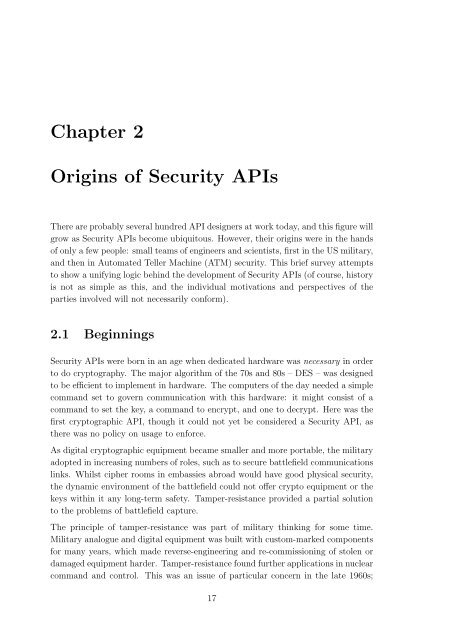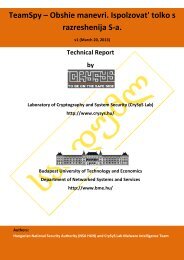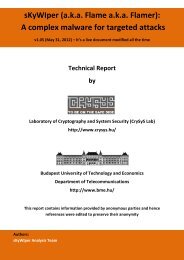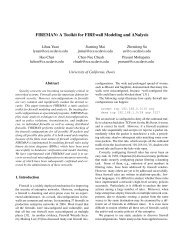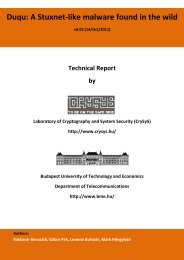Understanding Security APIs - CrySyS Lab
Understanding Security APIs - CrySyS Lab
Understanding Security APIs - CrySyS Lab
You also want an ePaper? Increase the reach of your titles
YUMPU automatically turns print PDFs into web optimized ePapers that Google loves.
Chapter 2<br />
Origins of <strong>Security</strong> <strong>APIs</strong><br />
There are probably several hundred API designers at work today, and this figure will<br />
grow as <strong>Security</strong> <strong>APIs</strong> become ubiquitous. However, their origins were in the hands<br />
of only a few people: small teams of engineers and scientists, first in the US military,<br />
and then in Automated Teller Machine (ATM) security. This brief survey attempts<br />
to show a unifying logic behind the development of <strong>Security</strong> <strong>APIs</strong> (of course, history<br />
is not as simple as this, and the individual motivations and perspectives of the<br />
parties involved will not necessarily conform).<br />
2.1 Beginnings<br />
<strong>Security</strong> <strong>APIs</strong> were born in an age when dedicated hardware was necessary in order<br />
to do cryptography. The major algorithm of the 70s and 80s – DES – was designed<br />
to be efficient to implement in hardware. The computers of the day needed a simple<br />
command set to govern communication with this hardware: it might consist of a<br />
command to set the key, a command to encrypt, and one to decrypt. Here was the<br />
first cryptographic API, though it could not yet be considered a <strong>Security</strong> API, as<br />
there was no policy on usage to enforce.<br />
As digital cryptographic equipment became smaller and more portable, the military<br />
adopted in increasing numbers of roles, such as to secure battlefield communications<br />
links. Whilst cipher rooms in embassies abroad would have good physical security,<br />
the dynamic environment of the battlefield could not offer crypto equipment or the<br />
keys within it any long-term safety. Tamper-resistance provided a partial solution<br />
to the problems of battlefield capture.<br />
The principle of tamper-resistance was part of military thinking for some time.<br />
Military analogue and digital equipment was built with custom-marked components<br />
for many years, which made reverse-engineering and re-commissioning of stolen or<br />
damaged equipment harder. Tamper-resistance found further applications in nuclear<br />
command and control. This was an issue of particular concern in the late 1960s;<br />
17


